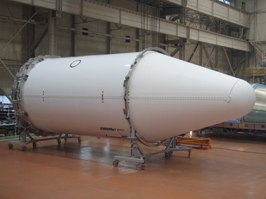H-IIA Launch Vehicle Fairing Delivered
Feb. 08, 2010

Tokyo, February 8, 2010 — Kawasaki Heavy Industries, Ltd. announced today that it has shipped a payload fairing (PLF*1) for the H-IIA Launch Vehicle No.17 to Japan’s Tanegashima Space Center. Design and manufacturing of the PLF was performed at Kawasaki’s Gifu Works before the fairing was assembled and shipped from its Harima Works. Upon arrival at the Tanegashima Space Center, the PLF will be delivered to Mitsubishi Heavy Industries, Ltd. who will be executing the launch. Mitsubishi will incorporate the PLF into the H-IIA Launch Vehicle No. 17 in preparation for the upcoming launch scheduled for this spring. The four-meter diameter PLF has a single launch configuration (4S) and can accommodate a large satellite similar to those carried by the NASA space shuttle or the European Space Agency’s Ariane V. The H-IIA Launch Vehicle No. 17 will carry the Planet-C*2 (Akatsuki), an unmanned spacecraft designed to explore Venus that was developed by the Japan Aerospace Exploration Agency (JAXA). It will also carry JAXA’s small solar powered sail demonstration vehicle (IKAROS*3) as well as four smaller satellites that were selected by JAXA after public solicitation. Since delivering the first PLF for the H-II launch vehicle in 1988, Kawasaki has supplied payload fairings for a total of seven H-II launch vehicles. Kawasaki has a proven track record of designing and building a variety of PLFs for H-IIA launch vehicles, including four-meter single (4S), four-meter dual (4/4D), and five-meter single fairings(5S). These PLFs have been a key component in 16 H-IIA launch vehicles to date. Kawasaki has developed and manufactured a wide spectrum of H-IIA launch vehicle PLFs designed to meet a broad range of payload specifications, including the launch of large satellites as well as the simultaneous launch of two satellites. Kawasaki is playing a vital role in today’s satellite launch industry via the development and production of cutting-edge PLFs.
*1. A payload fairing is an enclosure installed at the tip of a launch vehicle that protects the satellite from aerodynamic heating, acoustic noise and vibration during liftoff. After the launch vehicle leaves the earth’s atmosphere, the fairing splits in two and is jettisoned, allowing the satellite to separate from the launch vehicle. *2. Planet-C is a spacecraft developed by JAXA for studying the climate and meteorological phenomena surrounding Venus. Its mission is to closely observe Venusian atmospheric dynamics via continuous imaging data obtained by ultraviolet and infrared cameras as well as radio waves. *3. IKAROS (Interplanetary Kite-craft Accelerated by Radiation of the Sun) is a spaceship which uses solar radiation pressure on its ultra thin sail as a means of propulsion. It will be used to demonstrate that a spacecraft can cruise through space with only the use of a sail and generate electricity by means of thin film solar cells.
|
|||||||||||





